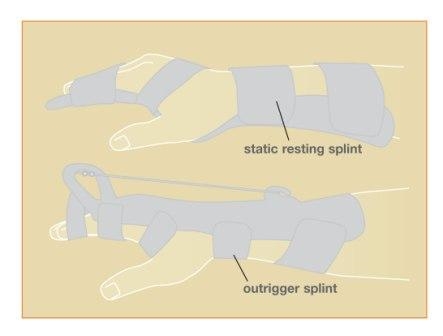Home | Education | Arthritic Conditions | Joint Replacement Surgery


Figure 2: Common types of splints used for post-op hand therapy
The information on this webpage is based on material from the American Society for Surgery of the Hand and is for educational purposes only.
Joint Replacement Surgery
Joint Replacement Surgery
In a normal joint, bones have a smooth, glistening surface made of a substance called articular cartilage on their ends that allows one bone to glide easily against another. Joints are lubricated by a thin layer of fluid (synovial fluid) that acts like oil in an engine to keep moving parts gliding smoothly. When the articular cartilage wears out or is damaged or the joint fluid is abnormal, problems develop and joints often become stiff and painful – that’s arthritis. There are many types of arthritis, but the basic problem is the same in all types: the joint surfaces are worn out or not moving properly. In some cases, it may be possible to treat arthritic joints surgically, including “joint replacement” procedures.
What does it mean to have a "joint replacement" or an "artificial joint"?
The abnormal bone and lining structures of the involved joint are removed surgically, and new parts are inserted in their places. These new parts may be made of special metal or plastic (certain forms of polyethylene) or specific kinds of carbon-coated implants. The new parts allow the joints to move again with little or no pain.What kind of joints can be replaced?
- Finger joints (the “first” joint, called the PIP joint) (see Figure at right)
- “Knuckle” joints (called MP joints, where the finger joins the hand) (see Figure at right)
- Wrist joints (see Figure at right)
When should joint replacement surgery NOT be done?
Artificial joints should not be done if you have:- An infection in the joint
- Muscles or tendons that normally would move the involved joint are damaged and cannot be repaired to allow a new joint to work properly
- Other joint replacements or hardware from other surgery that would block insertion or motion of a new implant
- Problems with skin or bone quality
What are some alternative procedures besides joint replacement surgery for arthritis?
- Joint injections (steroid preparations are used most commonly)
- Oral medications (such as aspirin or anti-inflammatory medicines)
- Physical therapy exercises and protective splints
- Surgery to fuse bones together – called “arthrodesis” – which relieves pain by eliminating motion between damaged joint surfaces
- Surgery on tendons or ligaments to repair related joint injuries
What are the benefits of joint replacement surgery?
Artificial joints may help:- Reduce joint pain
- Restore or maintain joint motion
- Improve the look and alignment of the joint(s)
- Improve overall hand function
What are the risks of joint replacement surgery?
- Implant loosening, fracture or wear that occurs over time and which may require subsequent surgery to repair or replace the damaged parts
- Infection
- Joint stiffness or pain, if the procedure or implant fails
- Dislocation of the artificial joint
- Damage to vessels, nerves or other structures in the region of the surgery

Is therapy needed after surgery?
Yes, therapy supervised by a trained hand therapist is almost always required after any joint replacement surgery, usually for several months. Special splints are generally used depending on which joint was replaced and how the surgery was done.Figure 2: Common types of splints used for post-op hand therapy
How can you ensure the best results after joint replacement surgery?
- Follow your surgeon’s and therapist’s directions carefully; excessive use or "overdoing it" with your hand can damage the new joint(s)
- Be sure to call your surgeon if you experience a sudden increase in pain or swelling, or if your hand or wrist becomes red, hot, painful or crooked
- Contact Dr Smith or your therapist if you have specific questions about your new joint(s)